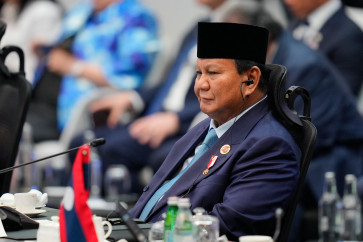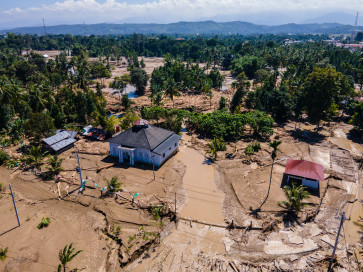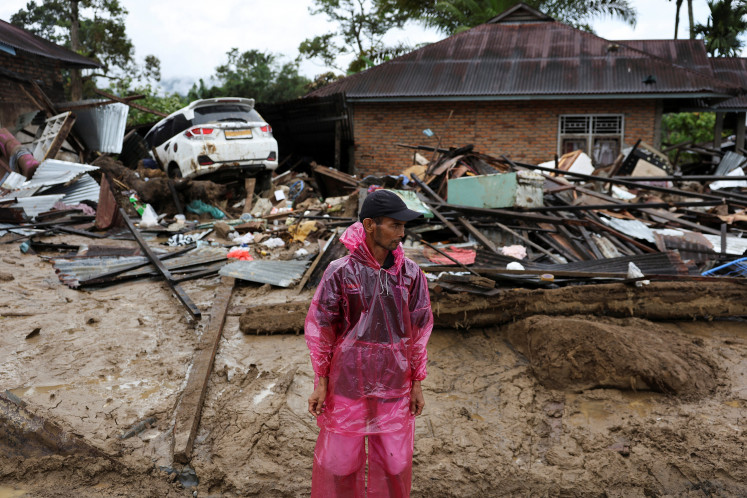Popular Reads
Top Results
Can't find what you're looking for?
View all search resultsPopular Reads
Top Results
Can't find what you're looking for?
View all search results'An Indonesian perspective on the Indo-Pacific'
The term âIndo-Pacificâ has become increasingly common in the lexicon of geopolitics
Change text size
Gift Premium Articles
to Anyone
T
he term 'Indo-Pacific' has become increasingly common in the lexicon of geopolitics.
In terms of geography, it refers to an important triangular spanning two oceans, the Pacific and Indian Oceans, bounded by Japan in the north, Australia in the southeast and India in the southwest, notably with Indonesia at its center. Thus as a result, in this largest archipelagic state in the world, amid its archipelagic waters, are found some of the most strategic sea lanes in the world: connecting the Indian and Pacific Oceans. Serving as highways for the movement of global trade, as well as of people and the associated ideas and cultural expressions they bring forth.
In the political and economic domain, it refers to an area encompassing some of the most dynamic economies in the world, with a rising role not only in the evolving global economic architecture, but also in the political arena as well.
Today, the Indo-Pacific region is an economic power in its own right. It serves as the engine for global economic growth.
The region has an aggregate population of some 3 billion. It is home to the world's largest democracies. Five of its 30 countries are among the 20 largest economies of the world. These account for about two-thirds of global trade.
Not least, the term Indo-Pacific brings into focus the reality of the interconnection between the futures of the Indian and the Pacific Oceans.
Whereas in the past one may identify distinct and separate regional cooperative architecture for the Indian and the Pacific Oceans, the future could see an emphasis on architecture that connects these two areas: Indo-Pacific frameworks. As a matter of fact, some of the forums are already reflecting such connectivity.
The 27 countries of the ASEAN Regional Forum (ARF), for example. And more significantly, perhaps, the East Asia Summit (EAS) which, despite the nomenclature, at Indonesia's initiative, includes India, Australia and New Zealand as original members.
For Indonesia, given its geography, the future course of the Indo-Pacific region is in our profound interest.
And today, I wish to highlight one particular and specific challenge: How do we maintain the 'pacific' in the Indo-Pacific? In other words, how many countries in the region work in common to maintain the peace and stability that have served them well?
A key objective, indeed, given that the many decades of peace and stability in the area have been instrumental in making possible the pursuit of economic development, progress and prosperity by the countries of the region, a 'peace dividend'.
Yet, multi-faceted challenges await.
Let me highlight three; and offer some thoughts in response.
First and foremost, challenges stemming from 'trust-deficit'.
On the Korean Peninsula, for example, while the Indo-Pacific region has long 'factored-in' the challenges there-in, recent developments may suggest a significant leap in the nature of the threat; the sharpening of distrust and its attendant cycle of tensions. And the stakes are getting ever higher.
A nuclear-capable DPRK, for example, may alter the security equation in the region ' proliferation pressures not unlike in the Indian subcontinent may ensue. In the absence of some kind of renewed efforts to promote dialogue and security ' to promote trust and confidence ' countries in the region may feel compelled to pursue guarantees of their own security at the expense of the other and, indeed, ultimately, to itself.
Not wishing to oversimplify, I believe that at the heart of the various complex and inter-related challenges on the Korean Peninsula, like many a potential conflict-situation, lies the issue of 'trust deficit'. Worst-case assumptions of the other's intention feeding action-reaction, a vicious cycle of increasing tensions and of deepening distrust. A situation where the perceived advantage of pre-emptive action leads a hitherto minor incident to escalate to a major crisis, and even, open conflict.
Essentially, I believe that means must be brought to disrupt the often apparently relentless rush toward conflict ' to end the sense of inevitability of conflict. Trust and confidence must be built and nurtured. The exercise of restraint must be rewarded; reciprocated. Mutual restraint. Hence communications need be established: formal and informal; governmental and non-governmental.
The establishment of lines of communications, especially in times of crisis, are not signs of weakness or acquiescence; rather they are means to decipher and convey intent, without prejudicing or sacrificing principled position.
A 'pacific' Indo-Pacific requires, therefore, modalities to build mutual trust and confidence. To substitute an all too often vicious cycle of tensions with a virtuous cycle of trust and confidence-building.
Second, unresolved territorial claims.
Ours is a region not exempt from these. Maritime: from the East China Sea to the South China Sea. Land borders: affecting major countries of the Indo-Pacific region sharing long common land boundaries. By their nature, they often defy prompt resolution.
Decades-long and painstaking negotiations are not uncommon. Further burdening already complex legal and technical issues are past history. Often, current issues are not contributing to conditions conducive for the peaceful and negotiated resolution of unresolved territorial claims.
________________
Trust and confidence must be built and nurtured. The exercise of restraint must be rewarded.
I believe that unresolved territorial claims, disputes even, do not have to equate conflict. In this connection, where the realities of territorial disputes are evident, this must be acknowledged by the parties concerned. Without, however, prejudicing or compromising the principled position of each of the parties.
In this manner, the claimant parties do away with the constant testing and prodding of the other's resolve and intentions; of dangerous and destabilizing 'show the flag' measures that may invite response from the other side ' escalating minor incidents to full blown crisis; and risking miscalculation of intent.
A 'pacific' Indo-Pacific, therefore, requires a commitment from parties to a territorial dispute to respect certain code of behavior or conduct in the affected area. In the South China Sea context, this has meant the drawing up of a regional code of conduct between ASEAN and China.
Elsewhere it may involve less formal arrangements or understandings. Miscalculations or unintended crisis. However, the essence remains: Avoid miscalculations or unintended crisis.
Ultimately, however, where a territorial dispute is prevalent, a 'pacific' Indo-Pacific must commit to peaceful settlement of disputes in accordance with the principles of international law and the Charter of the United Nations.
Third, managing the impact of change. Change permeates the Indo-Pacific region.
Change and transformation within countries: political and economic ' have ramifications far beyond their borders. As a matter of fact, the Indo-Pacific has been witness to some of the most fundamental process of change in recent decades. Reform and democratic change have been on the march ' for example from the Republic of Korea, the Philippines, Thailand, Indonesia and, today, in Myanmar. Further, Southeast Asia collectively, through ASEAN Political Security Community, has made democracy and reform key aspects of community-building.
Equally impactful has been the economic transformation of the Indo-Pacific region, turning the economies of the region into drivers of the global economic growth.
As change occurs, a new type of challenge has arisen. Essentially, whether the region will witness a relationship among countries marked by competition or partnership. The region certainly has its fair share of important 'bilaterals' with potentially profound implications to the region's peace and stability. In addition to the most commonly cited, for example China-US and US-Russia ties, others are equally significant. To cite a few: China-Japan, China-India, Japan-Republic of Korea, Japan-Russia and Russia-China. What's more, these relationships, competitive or otherwise, do not take place in a vacuum. They are inter-linked and affect one another.
In my view, a 'pacific' Indo-Pacific region requires a new paradigm in the region's inter-state relations. One not unlike that that has evolved in Southeast Asia through ASEAN. Thanks to the latter, the Southeast Asia region has put behind it a region that was once marked by inter-state rivalry; a region torn apart by the East-West divide. Instead, we are seeing a region engaged in a process of community-building, including in the political and security domains.
I believe that a fresh perspective from the Indo-Pacific region entails one, that promotes a 'dynamic
equilibrium'.
The word 'dynamic' suggests recognition that change is inherent and a constant in the region. It is a natural phenomenon that cannot and should not be artificially resisted. At the same time, 'equilibrium' reminds that this state of constant change does not imply an anarchical state of affairs: either due to the unchecked preponderance of a single state, or due to the disorder or uncertainty associated by a multipolar region. Instead, peace and stability in the region ought to be brought about through the promotion of common security, prosperity and stability. A recognition that security can only be enjoyed sustainably by states if it is viewed as a common good and not one that is obtained at the expense of the other. A dynamic equilibrium thus is marked by an absence of preponderant power not through the rigidity, rivalry and tensions common to the pursuit of a balance of power model. Instead, through the promotion of a sense of common responsibility in the endeavor to maintain the region's peace and stability.
To reflect such an approach, I am of the view that we should be ready to work towards an Indo-Pacific wide treaty of friendship and cooperation. A commitment by states in the region to build confidence, to solve disputes by peaceful means, and to promote a concept of security that is all encompassing; underscoring that security is a common good.
A treaty, not unlike the Treaty of Amity and Cooperation in Southeast Asia, which has been such an instrumental part in that region's evolution from one marked by conflict to one which is on the eve of a community. A treaty which provides flesh and strengthens the commitment already expressed by the East Asia Summit participating countries through the so-called 'Bali Principles' on the Principles for Mutually Beneficial Relations agreed at the East Asia Summit in 2011.
The Indo-Pacific must continue to be a net contributor to international peace and security. This requires an Indo-Pacific region that is marked by mutual trust and confidence; a region which demonstrates a commitment to the pursuit of peaceful settlement of disputes; and a region which embraces change as a force for common good.
If the countries of the region accomplish these three goals, I am sure that the Indo-Pacific region, which enfolds both the United States and Indonesia, will rise above all the challenges it is confronting today.
And the world will be so much the better for it.
The writer is foreign minister. The article is his keynote speech at the Conference on Indonesia in Washington, D.C., on May 16, 2013.










